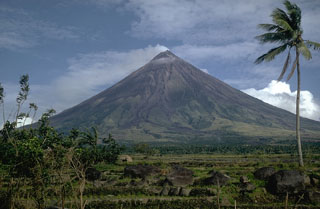Report on Mayon (Philippines) — 9 December-15 December 2009
Smithsonian Institution / US Geological Survey
Weekly Volcanic Activity Report, 9 December-15 December 2009
Managing Editor: Sally Sennert.
Please cite this report as:
Global Volcanism Program, 2009. Report on Mayon (Philippines) (Sennert, S, ed.). Weekly Volcanic Activity Report, 9 December-15 December 2009. Smithsonian Institution and US Geological Survey.
Mayon
Philippines
13.257°N, 123.685°E; summit elev. 2462 m
All times are local (unless otherwise noted)
According to news articles, PHIVOLCS reported that on 11 December an explosion from Mayon was detected by the seismic network. On 14 December, incandescence emanated from the lava dome in the summit crater and incandescent material traveled as far as 3 km down the S and SE flanks. At least five minor explosions were detected by the seismic network. Some local ashfall was reported. The Alert Level was raised to 3, prompting the order to evacuate about 50,000 people living within an 8-km radius from the base of the volcano.
Geological Summary. Symmetrical Mayon, which rises above the Albay Gulf NW of Legazpi City, is the most active volcano of the Philippines. The steep upper slopes are capped by a small summit crater. Recorded eruptions since 1616 CE range from Strombolian to basaltic Plinian, with cyclical activity beginning with basaltic eruptions, followed by longer periods of andesitic lava flows. Eruptions occur predominately from the central conduit and have also produced lava flows that travel far down the flanks. Pyroclastic density currents and mudflows have commonly swept down many of the approximately 40 ravines that radiate from the summit and have often damaged populated lowland areas. A violent eruption in 1814 killed more than 1,200 people and devastated several towns.
Sources: Inquirer.net, Philippine Daily Inquirer, The Manila Times

